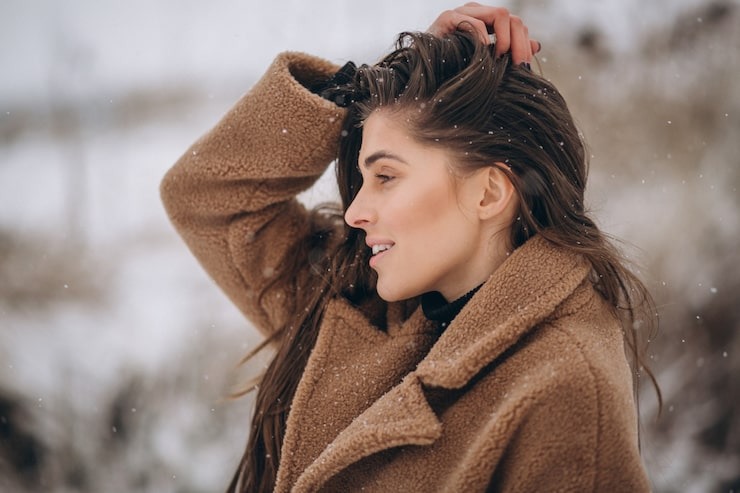
Many people wonder if hair grows faster in the winter. A few accept cold climate moderates development. Others think dry winter discuss helps hair grow stronger. The truth is a blend of science, way of life, and care habits.
Understanding how hair behaves in different seasons can help you arrange way better hair schedules and indeed select colors that coordinate the season, like winter blonde hair colors or profound winter hair colors.
The Science of Hair Growth
Hair growth is determined by a few factors:
- Genetics
- Hormones
- Diet
- Scalp health
- Seasonal changes
On normal, hair grows about half an inch per month or generally 6 inches per year. A few thinks about propose regular changes affect the hair cycle. The anagen stage, or the active growth phase, can be impacted by daylight, temperature, and blood circulation.
Read Also: How to Dress Like a Fashionable Older Italian Man?
In winter, days are shorter, and there is less daylight. This influences vitamin D levels, which play a part in hair follicle action. In any case, colder temperatures do not naturally make hair develop speedier or slower. Hair development is by and large reliable all through the year for most people.
Does Hair Grow Faster in the Winter?

No, your hair does not grow faster in the winter; it's that hair growth slows during colder season. There are a few reasons for this. First of all, blood supply to the scalp can be reduced. Second, the skin produces less Vitamin D from sunlight. And finally, a cold climate and indoor heat can dry out the scalp.
The idea that hair grows faster in the winter is mostly genuine for a few individuals. Here’s why:
Scalp Blood Circulation: Cold climate can progress circulation when you take warm showers or rub the scalp. Superior blood stream brings more supplements to hair follicles. This may somewhat bolster hair growth.
Reduced Hair Breakage: In winter, individuals regularly wash hair less habitually. This makes a difference avoid breakage and part closes. Whereas hair may not grow faster, it may show up longer since less is breaking off.
Hormonal Balance: Some inquire about recommends regular changes in hormones, like melatonin and prolactin, may impact hair thickness and development. Hair may grow slightly faster in late winter or early spring when the body plans for more sunlight.
How Hair Care Differs in Winter?
Winter requires diverse hair care schedules. Cold discuss, dry indoor warm, and wind can make hair fragile. To keep hair sound and solid, take after these tips:
- Use moisturizing shampoos and conditioners
- Apply leave-in conditioners or hair oils
- Avoid hot water for washing hair
- Limit warm styling
- Wear protective hats to prevent wind and cold damage
Proper care guarantees that hair remains solid, and sound hair can hold length superior. This is particularly vital if you are attempting out winter blonde hair colors or profound winter hair colors, as color-treated hair can be more delicate in cold, dry months.
Winter Hair Color Trends
Choosing a regular hair color can too impact your hair care schedule. Well known winter hair colors incorporate winter blonde hair colors, which regularly have cool, frosty tones. These shades see shocking in the winter light. They can brighten your complexion and complement cozy winter outfits.

You Must Also Like: Hairstyles for Men with White Hair: From Classic to Modern
The deep winter hair colors are another popular selection. Rich, muted hues such as chocolate, coffee or deep burgundy look perfect for the chill. These colors add warmth to light winter complexions and often need fewer visit touch-ups than other hues.
Does Coloring Affect Hair Growth?
The process of hair coloring doesn't affect the rate of hair growth. Nonetheless, chemical medications can weaken hair that cause damage or split terminals. This may make hair show up shorter. To keep hair solid whereas testing with winter blonde hair colors or profound winter hair colors, take after these tips:
- Deep condition hair weekly
- Use sulfate-free shampoos
- Avoid intemperate warm styling
- Trim routinely to avoid part ends
Healthy strong hair looks longer & more full. So, while not necessarily racing through development (as winter can speed things and summer doesn’t), proper care does make a noticeable difference.
Nutrition and Winter Hair Health
Your diet also plays a role in hair growth. New natural products and vegetables can be reduced in vitamins and minerals that are lower in the winter season, a number of us do not eat enough fresh brand name-new fruit. Hair requires its nutrients to stay strong:
- Protein for structure
- Iron for oxygen delivery
- Vitamin D for follicle stimulation
- Omega-3 greasy acids for scalp hydration
- Zinc for sound growth
These supplements added to your winter slim down can increases hair growth. That's especially important if you're planning to maintain light winter blonde hair colors that will likely need a bit more maintenance.
Protecting Hair from Winter Damage
Winter climate can harm hair. It’s the cold winds, the dry indoor warm air, and idle power all combined. Prevent your hair from snapping off and to maintain the illusion of longer length:
- Wear a scarf or cap outdoors
- Use silk or glossy silk pillowcases
- Apply anti-static hair serums
- Moisturize hair regularly
Protecting hair in winter guarantees that your profound winter hair colors or lighter tones stay dynamic and sound. Harm control can make your hair see longer and shinier, indeed if development speed is unchanged.
Myths Almost Winter Hair Growth
There are numerous myths around winter hair development. Let’s address the most common:
Cold climate makes hair develop faster: Not precisely. Cold temperatures alone do not boost development. Solid follicles and appropriate nourishment matter more.
Hair develops speedier in cold climates: No logical prove demonstrates that geology influences hair development speed significantly.
Less washing rises to quicker growth: While less washing diminishes breakage, it does not quicken follicle action. In any case, it can make hair show up longer over time.
Understanding these myths makes a difference set reasonable desires. Winter is more approximately ensuring and keeping up hair than speeding up growth.
Hair Development Tips for Winter
Even if hair doesn’t develop significantly speedier in winter, you can maximize length and wellbeing with these tips:
Scalp Knead: Boosts blood stream and invigorates follicles.
Moisturize: Avoids breakage and dryness.
Trim Routinely: Keeps closes solid and advances fuller-looking hair.
Use Warm Admirably: Dodge high-temperature styling.
Protect Hair Color: Use color-safe shampoos and conditioners.
Following these tips makes a difference keep up the see of long, solid hair whereas keeping winter blonde hair colors and profound winter hair colors vibrant.
Styling Tips for Winter Hair Colors
Winter colors, whether light or profound, advantage from cautious styling:
Winter Blonde Hair Colors: Delicate twists, braids, or smooth styles appear off frosty highlights beautifully.
Deep Winter Hair Colors: Straight, shiny looks or free waves upgrade dull tones.
Use warm protectants when styling. Moisturize colored hair to avoid blurring. Winter hair looks its best when matched with defensive care and regular hairstyles.
Conclusion
Hair does not grow faster in the winter. The rate remains more or less constant throughout the year. Either way: Caring for hair, eating right and reducing breakage can make winter hair appear longer and stronger. Scalp stimulation, hydration and security from cold damage help keep the length long and strong.
Winter is also a great time to play around with hair color. Winter Blonde Hair Color Ideas Blondes provide an excellent way to offset the wintry dullness, and winter blonde hair colors will restore life to your barren landscape of tresses with cooler tones. Picking the perfect color and looking after it ensures hair stays healthy, strong, and fabulous throughout the season.
Winter may not accelerate the pace of hair growth, but it presents a chance to protect your locks, embrace natural hues and maintain a healthy, lustrous appearance.





